Interesting geological features on La Gomera
[Home]
Übersicht /
Overview [click]
Interessantes zur Geologie und
Verwitterung Wollsackverwitterung
/ Spheroidal Weathering [click]
°°°°°°°°°°°°°°°°°°°°°°°°°°°°°°°°°°°°°°°°°°°°°°°°°°°°°°°°°°°°°°°°°°°°°°°°°°°°°°°°°°°°°°°°°°°°°°°°°°°°°°°°°°°°°°°°°°°°°°°°°°°°°°°°°°°°°°°°°°°°°°°°°°°°°°°°°°°°°°°°°°°°°°°
|

(1)
Benchijigua valley with Roque Agando and trade wind clouds over the ridge |
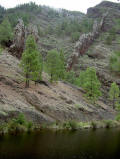
(2)
Dike
near La Laja (district of San Sebastián) |

(3)
Basaltic dike in a tuff environment, near Los Almácigos (district of
Alajeró) |
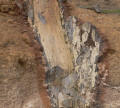
(4)
Phonolitic dike (road to Erque); note the adjacent "baked"
tephra |

(5)
Volcanic bomb, or just a lava-lifted ancient
boulder? (El Cedro) |

(6)
Breadcrust-type volcanic bomb (Isola di Vulcano, Italy) |
|

(7)
Volcanic bomb, exfoliating (upper Valle Gran Rey) |

(8)
This area near Arure is locally known as
Las Pelotillas - i.e. The Little Balls |

(9)
Las Pelotillas, slowly evolving from the lapilli tuff (eventually, they roll down) |

(10)
One of those tuff balls, from
recrystallization of calcite and zeolites |

(11)
Plagioclase decay leads to calcium carbonate deposits |

(12)
Druse
of calcite / hematite / analcime (?) upon ignimbrite |
|
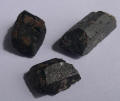
(13)
Amphibole and pyroxenes (appr. 1.5 cm long) |

(14)
Unweathered olivin beneath black obsidian |

(15)
The
bluish sheen of maghemite (incipient weathering of basalt) |
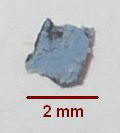
(16)
This
bluish chip from the rock in picture (15) is magnetic |

(17)
Fractured basaltic scoria with bluish spots of maghemite |

(18)
Porphyritic andesite with pyroxene phenocrysts |
|

(19)
Picritic basalt with augite, oxidized olivin, and calcite |

(20)
Vesicular dolerite with plagioclase (feldspar)
phenocrysts |

(21)
Xenoliths (foreign rocks) embedded in basaltic lava |
05_small.JPG)
(22)
Phonolite showing freshly broken face and weathering clefts |

(23)
Same
specimen (22), with manganese oxide dendrites on a cleft surface |

(24)
Ignimbrite (welded tuff) of oxidized ash and lapilli |
|
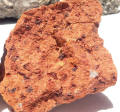
(25)
Heat-metamorphed soil, weathered to hematite-rich clay |

(26)
White: silicates of Al, Mg, ...; yellowish:
Fe-hydroxides; red: the heavier Fe-oxides |
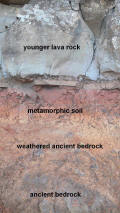
(27)
Typical repetitive vertical profile |

(28)
La Caldera (a flank crater)
and Calvario (an eroded laccolith)
|

(29)
Nightfall in Valle Gran Rey |

(30)
Nightfall in Valle Gran Rey |
°°°°°°°°°°°°°°°°°°°°°°°°°°°°°°°°°°°°°°°°°°°°°°°°°°°°°°°°°°°°°°°°°°°°°°°°°°°°°°°°°°°°°°°°°°°°°°°°°°°°°°°°°°°°°°°°°°°°°°°°°°°°°°°°°°°°°°°°°°°°°°°°°°°°°°°°°°°°°°°°°°°°°°°°
Weathering of mafic and intermediate rock
(Verwitterung von basischen magmatischen Gesteinen)
|

(31)
Porphyritic basalt with a brownish, Fe- oxide-hydroxide-rich weathering rind |

(32)
Trachybasalt: rind going from feldspar- rich
grey to a soft tan top layer (goethite & smectites) |

(33)
Trachyte pebble with whitish weathering rind (softer brownish outside eroded away) |

(34)
Vesicular dolerite with phenocrysts and red, hematite-rich weathering rind |

(35)
Basaltic ignimbrite (welded tuff) with red weathering rind |

(36)
Basaltic ash tuff with weathering rind |
|

(37)
Trachyte with white weathering rind (mostly kaolinite & halloysite) |

(38)
Porphyritic andesite-trachyte |

(39)
Phonolite, weathered outside and fresh fractures; from the dike in picture
(4) |

(40)
Phonolite with layered structure |
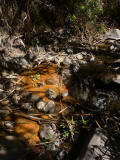
(41)
Ferrous hydroxide mud in a brook |

(42)
Basalt columns |
|

(43)
Shrinkage during solidification creates hexagonal columns |
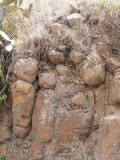
(44)
Weathering attacks the edges of cracked columns
and creates rounded corestones |
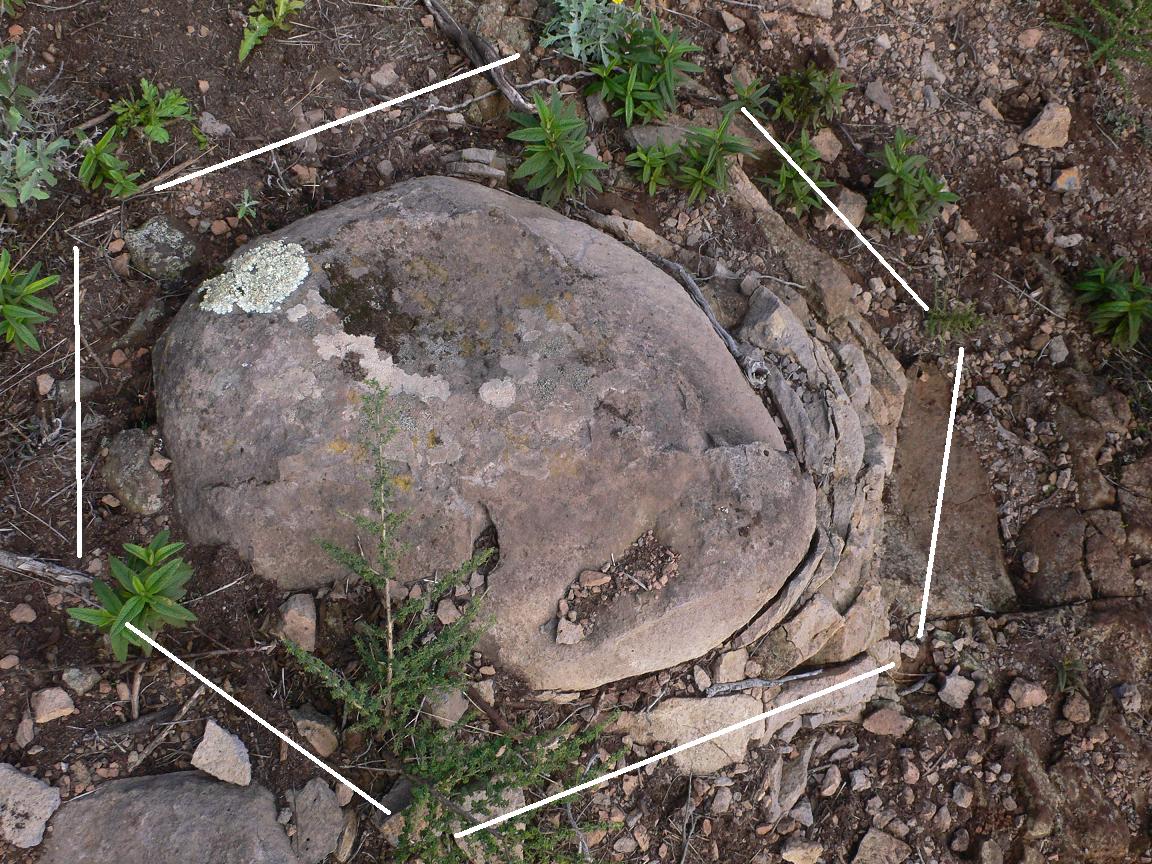
(45)
Weathering column, as seen from above, with a guess of the former
hexagonal shape |

(46)
Weathering dolerite (roadcut exposure; the red coating is oxidized volcanic
ash from farther uphill) |

(47)
Pyroclastic material "farther uphill", rich in iron oxide, which is being
washed down when it rains |

(48)
La Fortaleza de Chipude - an eroded trachytic laccolith |
|

(49)
Concentric 'peeling' of trachyte (Fortaleza de Chipude) |

(50)
A roadcut revealed this typical 'onion skin'
disintegration (east of Degollada de Peraza) |
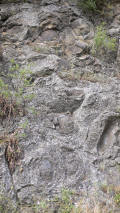
(51)
Diabase pillow lava, somwehat hidden in a steep roadcut (near La
Laguna Grande)... |

(52)
...and more yet, closer to the top (near La Laguna Grande) |
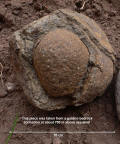
(53)
Is
this rock about to lay an egg? ... ;-)
(found near Epina) |
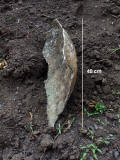
(54)
... and
is this a piece of eggshell? ... ;-)
(from near Las Hayas) |
|
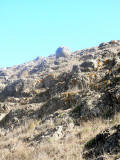
(55)
A neatly spherical corestone (Pedro Cojo, near Arure) |
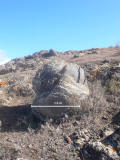
(56)
The same as (55),
close up |
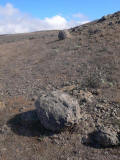
(57)
Erosion made these boulders roll down |

(58)
The
front one from (57), close-up (El Barro, near Arure) |

(59)
Here's where such a boulder had been resting (near Arure) |

(60)
Agglomerate and the scree slope of grus (near Chijeré) |
|

(61)
Mafic
pyroclastic agglomerate (near Chijeré) |

(62)
Saprolitified corestones, still embedded ... |
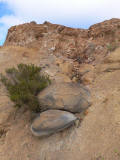
(63) ...
and here fallen down (near Chijeré) |
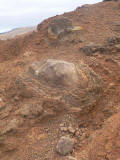
(64)
Corestones with 'weathering rindlets' |

(65)
What
once was an agglomerate (near Chijeré) ... |

(66) ...
lies now, exposed by erosion, upon weathering grus |
|

(67)
Grossly reduced volcanic bomb or block (near Chijeré) |

(68)
Fe2O3-biased
rindlets (near Chijeré)
|

(69)
Broken corestone, showing unweathered porphyritic basalt
(dolerite) |
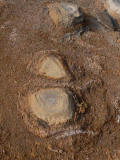
(70)
Grus
and the core remains of onion skin weathering |
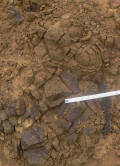
(71)
Spheroidal shapes in gabbro-grus (near Chijeré) |

(72)
Corestone, modified to saprolite by acidic water from overlying soil (La
Quintana / Arure) |
|

(73)
Phonolitic saprolite strata beneath a stratum of soil (La Quintana /
Arure) |
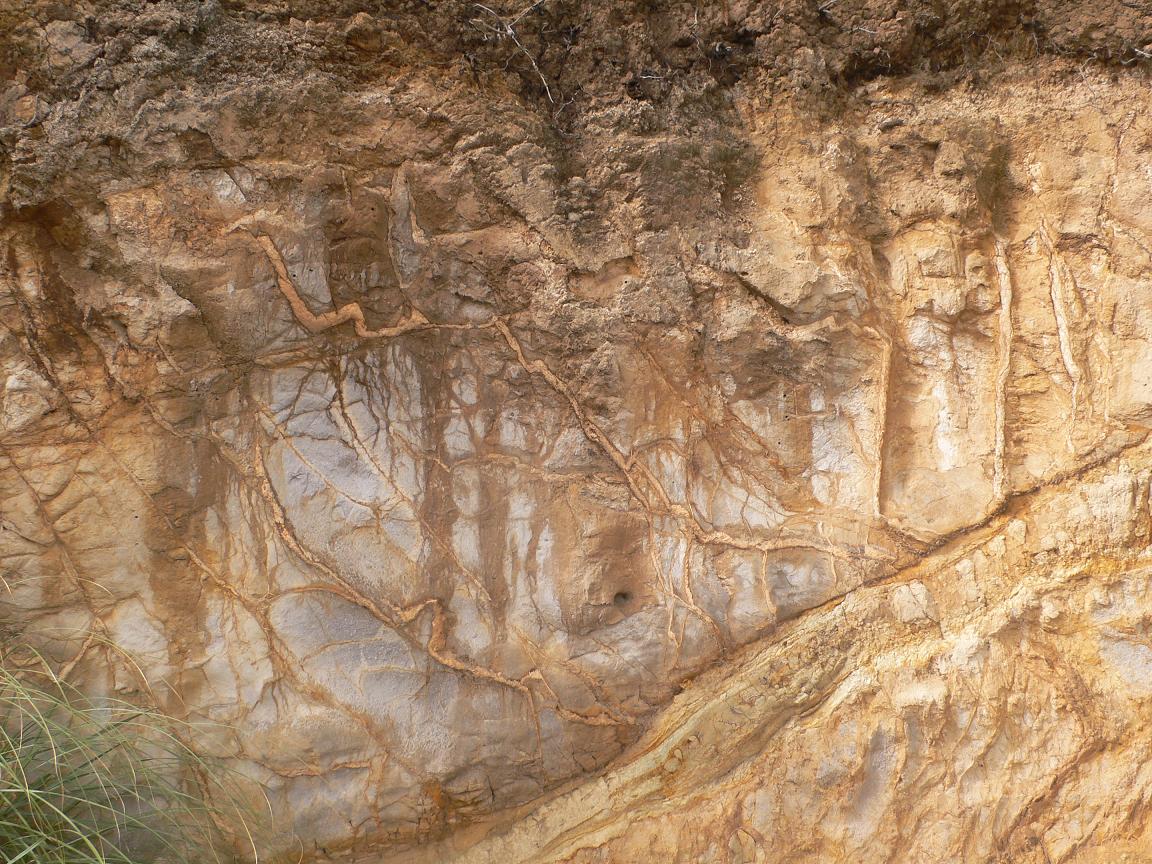
(74)
Fossilized plant roots (near Presa de Las
Rosas) |
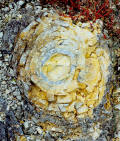
(75)
Saprolitic basalt stump (La Cancela, above Hermigua) |

(76)
Saprolite (possibly a pyroclastic surge deposit, above Epina) |

(77)
Volcanic ashes and a 7 metre wide dike (above Epina) |

(78)
Metamorphic aureole adjacent to the dike in the picture on the left |
°°°°°°°°°°°°°°°°°°°°°°°°°°°°°°°°°°°°°°°°°°°°°°°°°°°°°°°°°°°°°°°°°°°°°°°°°°°°°°°°°°°°°°°°°°°°°°°°°°°°°°°°°°°°°°°°°°°°°°°°°°°°°°°°°°°°°°°°°°°°°°°°°°°°°°°°°°
Solidified basaltic lava
from magmas with different
gas concentrations and cooling rates
|

(79)
Obsidian - no gas, rapid cooling under pressure (Isola di Lípari, Italy) |

(80)
Vesicular (porous) obsidian, with trapped gas
bubbles (Isola di Lípari, Italy) |

(81)
Almost pumice (rapid cooling under pressure relief) |

(82)
Vesicular basalt (brownish spots are weathered olivin phenocrysts) |
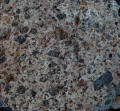
(83)
Porphyritic basalt - no gas, slow cooling led to phenocryst growth |

(84)
Massive, effusive basalt (broken; note the weathering rind on its outer
surfaces) |
°°°°°°°°°°°°°°°°°°°°°°°°°°°°°°°°°°°°°°°°°°°°°°°°°°°°°°°°°°°°°°°°°°°°°°°°°°°°°°°°°°°°°°°°°°°°°°°°°°°°°°°°°°°°°°°°°°°°°°°°°°°°°°°°°°°°°°°°°°°°°°°°°°°°°°°°°°
Most of the
Island of La Gomera is basalt, with some local trachyte
and phonolite intrusions. Depending on the
amount of gas in the magma, the lava rock can come in different
configurations: From obsidian (amorphous glass)
to effusive basalt lava (which has a crystalline matrix),
vesicular basalt (showing gas bubbles) to even pumice
(when
high gas concentration in the melt has caused the lava to froth). All this, when ejected explosively, can drop
out as to what is termed pyroclastic material, such as scoria or volcanic
ashes (coarse or fine-grained material).
Weathering,
quakes or varying temperatures can cause the bedrock (particularly those typical basalt columns) to
develop cracks
and clefts. As edges and corners are more easily weathered away, rocks and
boulders become
more and more rounded
in shape over the ages.
Pressure relief after removal of an overburden and, more frequently, thermal
stress can cause rocks to develop
concentric cracks, which makes them decay layer by layer. What remains is a
cluster of
peeling-off 'rindlets' that
enclose
a 'corestone' which, eventually, will also turn into grus. This process is called 'spheroidal weathering' or
'onion skin weathering'. It is not confined to massive rocks, but can also occur
in grus and mudstone [Fig. (71)].
This seems to be a
collective phenomenon and as such a manifestation of the emergent behaviour of
nature.





